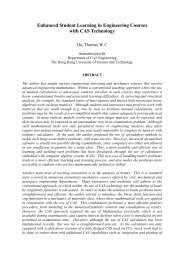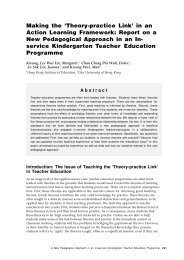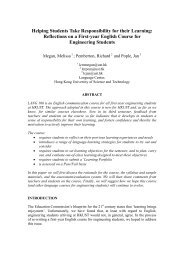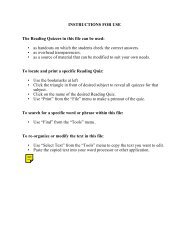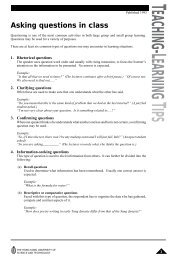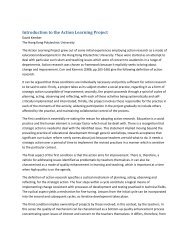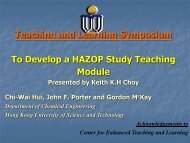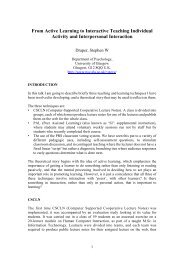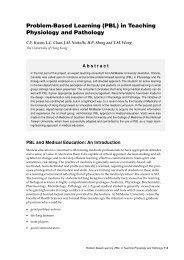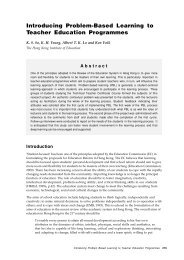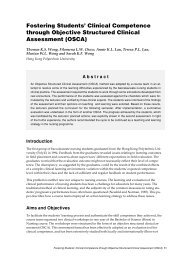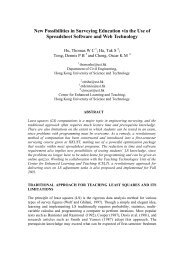Implementing Peer Assessment to Improve Teaching and Learning
Implementing Peer Assessment to Improve Teaching and Learning
Implementing Peer Assessment to Improve Teaching and Learning
Create successful ePaper yourself
Turn your PDF publications into a flip-book with our unique Google optimized e-Paper software.
Methodology<br />
First Cycle<br />
The description of the action learning project on peer assessment starts from an initial reflection<br />
explaining the underlying reasons for implementing this method.<br />
Initial Reflection<br />
The importance of developing student self reliance <strong>and</strong> critical appraisal skills were the underlying<br />
reasons for implementing peer assessment. In the specific context where the method was introduced,<br />
all students were teachers studying in the Postgraduate Diploma in Education Course offered<br />
by the Department of Education Studies at the Hong Kong Baptist University. The use of<br />
peer assessment aimed at encouraging their active participation in the learning process as well as<br />
facilitating the reflective aspect of assessment.<br />
Plan<br />
Plans were made <strong>to</strong> introduce peer assessment in<strong>to</strong> one of the subjects taught in the Postgraduate<br />
Diploma in Education Course. The assessment of this subject comprised two components: course<br />
work (60%) <strong>and</strong> a term paper (40%). A decision was made <strong>to</strong> introduce peer assessment in the<br />
course work component which involved a group project.<br />
Act<br />
In the first cycle, the method of peer assessment was introduced in the subject of ‘Curriculum Studies’,<br />
which is a common core subject offered <strong>to</strong> all students in the first semester of the second year<br />
of their Postgraduate Diploma in Education Course. Two forms of peer assessment were introduced.<br />
Students were required <strong>to</strong> write a project in groups of three <strong>to</strong> five <strong>and</strong> present it <strong>to</strong> the class. In the<br />
first form of assessment, students assessed the overall performance of each group in the presentation.<br />
In the second form of assessment, students within each group assessed the contribution of<br />
their fellow students <strong>to</strong> both the written work <strong>and</strong> the oral presentation. Based on the contribution<br />
ratings, the mark of each individual student was then calculated using a method which was developed<br />
by Goldfinch <strong>and</strong> Raeside (1990) <strong>and</strong> later simplified <strong>and</strong> improved by Conway, Kember,<br />
Sivan <strong>and</strong> Wu (1993). Both forms of assessment were based on a set of criteria using a five point<br />
Likert scale ranging from ‘outst<strong>and</strong>ing’ <strong>to</strong> ‘poor’.<br />
Students were asked <strong>to</strong> assess their groupmates <strong>and</strong> classmates based on criteria which were set by<br />
the lecturer. Each student was given two separate forms. The criteria set for the assessment within<br />
each group referred <strong>to</strong> the level of participation of the individual in six different tasks. These included<br />
the summary of each individual’s work, organisation <strong>and</strong> combination of the individuals’<br />
work, writing the combined group paper, producing a clear explanation in the written description,<br />
organisation of the presentation <strong>and</strong> contribution <strong>to</strong> the presentation. Students were also given the<br />
option <strong>to</strong> add or substitute tasks which they felt were important for their project.<br />
The criteria for assessing the groups’ presentations referred <strong>to</strong> the content <strong>and</strong> context of the presentation.<br />
The criteria were established based on the themes on which students were asked <strong>to</strong> write<br />
their project. In this specific case, the themes related <strong>to</strong> reflection on an existing syllabus with<br />
which students were familiarised. Students were asked <strong>to</strong> evaluate the syllabus in terms of its aims<br />
<strong>and</strong> objectives <strong>and</strong> fac<strong>to</strong>rs affecting its development. Five criteria related <strong>to</strong> the content of the presentation<br />
<strong>and</strong> three criteria related <strong>to</strong> the context of the presentation. Concerning the context of the<br />
presentation, students were asked <strong>to</strong> assess the presentation in terms of its clarity, how interesting<br />
it was <strong>and</strong> also the extent <strong>to</strong> which they unders<strong>to</strong>od the material.<br />
18 <strong>Assessment</strong>



